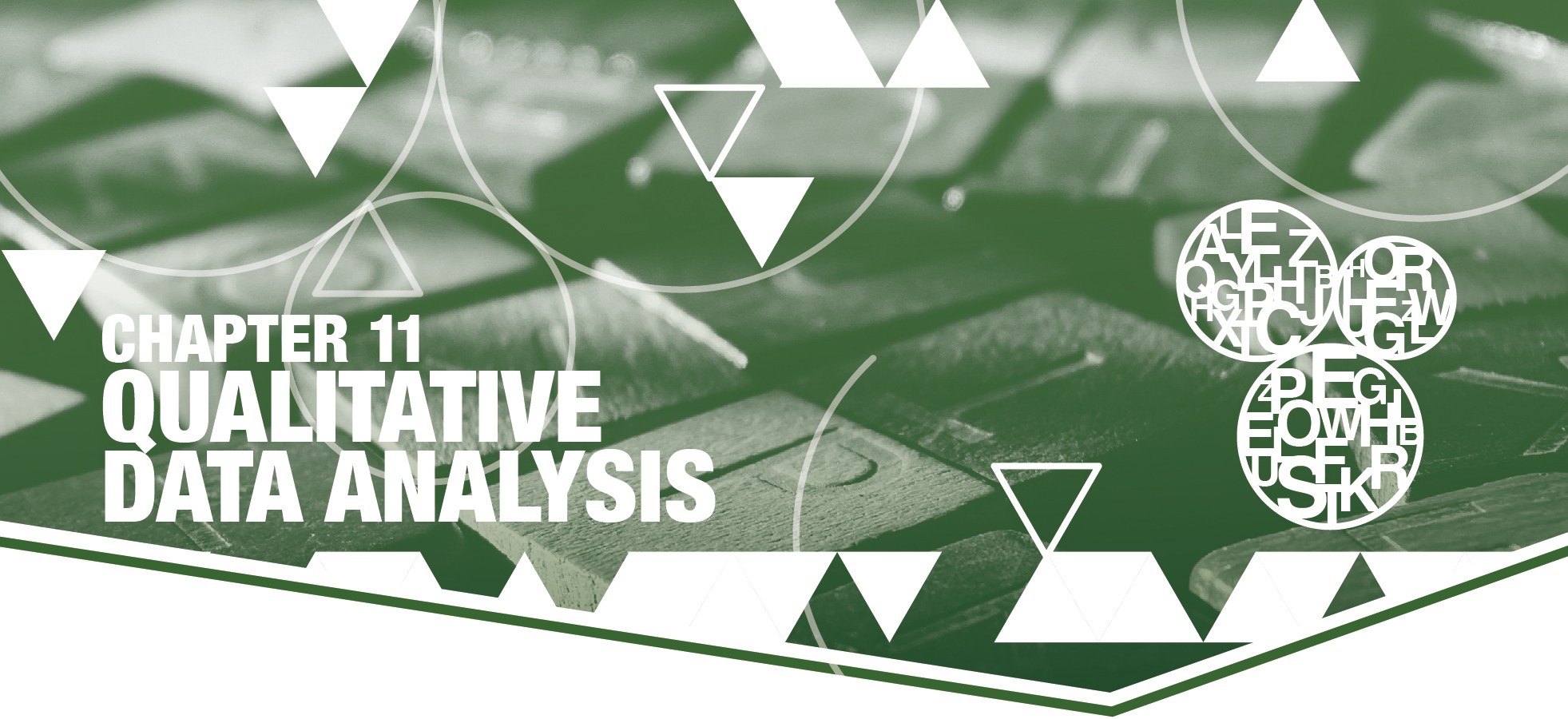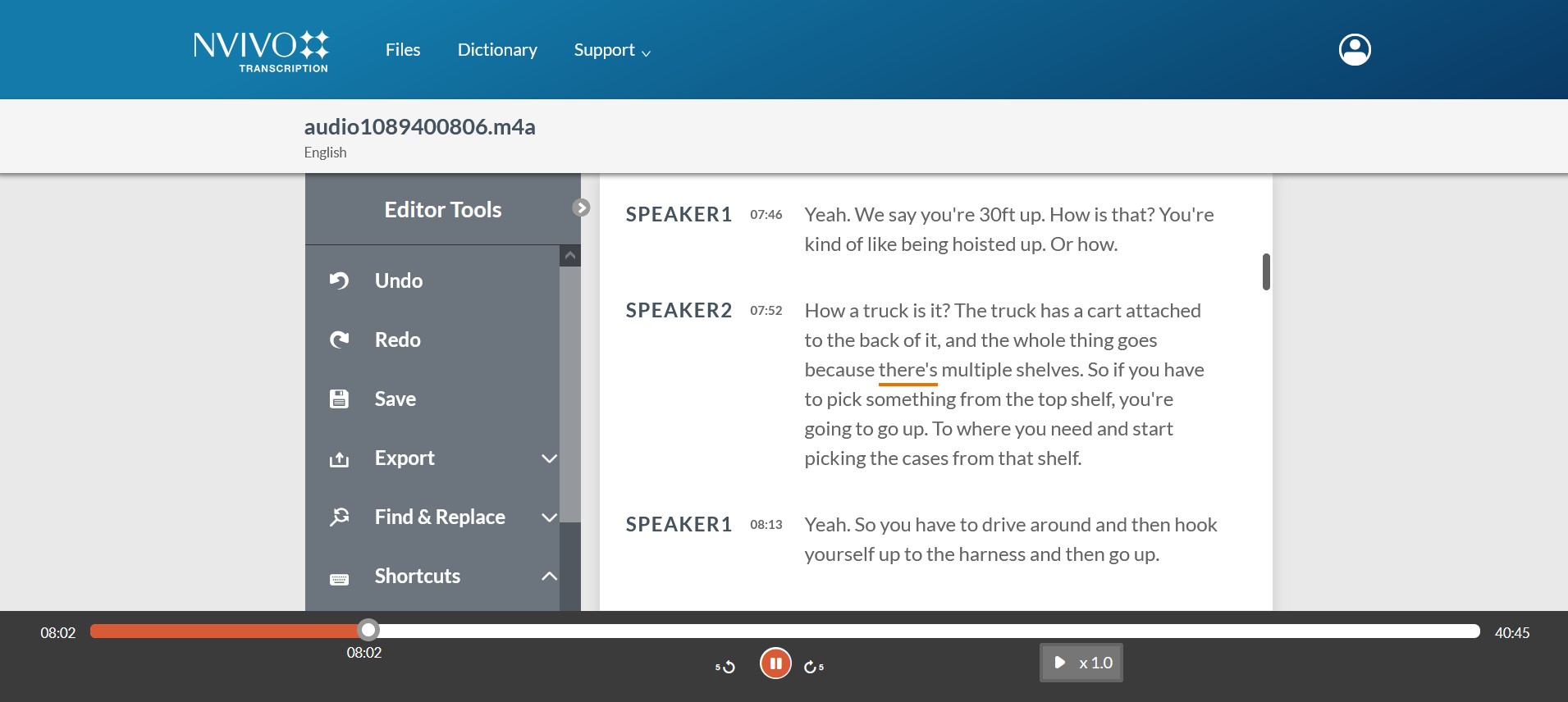11. Qualitative Data Analysis
 How can you analyze a vast set of empirical evidence acquired through participant observation, in-depth interviews, focus groups, audio or video recordings, or secondary documents? Qualitative data analysis specializes in condensing large amounts of qualitative data into more manageable bits of information that represent patterns and relationships visible across a sample. During this analysis process, you review your ethnographic field notes, interview transcripts, or other qualitative data sources and try to make sense of what is there: what tendencies can be seen in the data, what processes are described or explained, what social meanings are being conveyed by people’s actions and words, and so on.
How can you analyze a vast set of empirical evidence acquired through participant observation, in-depth interviews, focus groups, audio or video recordings, or secondary documents? Qualitative data analysis specializes in condensing large amounts of qualitative data into more manageable bits of information that represent patterns and relationships visible across a sample. During this analysis process, you review your ethnographic field notes, interview transcripts, or other qualitative data sources and try to make sense of what is there: what tendencies can be seen in the data, what processes are described or explained, what social meanings are being conveyed by people’s actions and words, and so on.
How is qualitative data analysis different from quantitative data analysis? To review what we discussed in Chapter 4: Research Questions, experiments and survey research typically take a deductive approach that is focused on theory testing—providing evidence to support or challenge researchers’ hypotheses. Qualitative research, in contrast, tends to pursue an inductive approach that is about theory building. While the deductive researcher starts with a theory, derives concrete hypotheses from that theory, and tests those hypotheses using empirical data, the inductive researcher starts with data and tries to sketch out a theory that makes sense of the patterns in that data.
The fact that a qualitative study often starts with immersing yourself in the data is important. That’s because one key advantage of the qualitative approach to data collection and analysis is that it allows for these two procedures to occur more or less at the same time. For instance, you might decide to conduct an interview and do a preliminary analysis of your data before proceeding to the next interview. Doing so allows you to correct potential flaws in your interview guide or adjust it to capture the phenomenon of interest more precisely or fully. Another advantage of the qualitative approach, as we’ve mentioned before, is that it can be iterative. Drawing from what you uncovered in your last observation or interview, you might focus your next observation or interview on a topic that needs further explanation, or you might see if a pattern you observed holds up with a different respondent or in a different social context.
For these reasons, the analysis stage of qualitative research looks very different than it does for quantitative research, which tends to stringently separate data collection and data analysis. Not surprisingly, it is much more common in quantitative research to use secondary data, data that other researchers collected. Quantitative researchers may spend their entire careers analyzing such data and never field an original survey of their own construction. And as we describe further in Chapter 14: Quantitative Data Analysis, finding existing quantitative data to analyze is easy—government agencies and other organizations regularly track relevant trends, and sprawling online archives contain ready-to-analyze datasets. While qualitative data archives do exist—such as the Qualitative Data Repository and the U.S. Library of Congress’s American Life Histories and American Folklife Center collections of oral histories—they are much fewer in number. One reason is that, as we’ve discussed before, ethnographers and in-depth interviewers are part of their measurement instrument. Any data they collect is filtered through their subjective experiences, hunches, and interpretations. They determine what is true, what is connected to what, and what it all means. Qualitative analysis depends heavily on the researcher’s personal knowledge of where the data came from—that is, their deep familiarity with the social context in which they observed the phenomenon of interest. While this is true for all data to some extent, the closeness that qualitative researchers have to their data mean that the processes of data collection and analysis are often inseparable.
In this chapter, we’ll give you a sense of how you can break down the text of your field notes or interview transcripts into useful bits of meaning that can be categorized as codes. As we’ll demonstrate, generating these codes will allow you to see patterns in your data. It will flag surprises that may challenge or overturn the way you think about a phenomenon. Eventually, it will give you a sound basis on which to construct or refine theories. You can pursue this coding process by using specialized software or just by writing up coding memos in your word processor. We’ll go over some of the basics of these different approaches. We’ll end the chapter by talking about best practices for writing up your qualitative data in a clear and accessible form.
Qualitative data analysis can be thrilling because of the intense creativity that is involved. Your sociological imagination can lead you to a number of “a-ha” moments where you piece together surprising connections or come up with compelling explanations. If you’re lucky, the development of such theories will inspire other scholars and launch new lines of research. What’s more, the findings of qualitative research can be particularly rewarding for research participants, who may appreciate getting a bird’s-eye view of their everyday experiences—one that is rooted in the actual facts of their lives, rather than imposed from up high by theorists. With that power, of course, comes the responsibility of analyzing your data both creatively and rigorously.
Transcribing Interview Data

When qualitative data analysis involves interview data, the analysis usually begins with transcribing the audio recordings of those sessions. During this process, a transcript—a written, usually word-for-word rendition of the conversation—is created by playing the recording back and typing in each word that is spoken, noting who spoke which words. In general, it is best to have a verbatim transcript, one that reports exactly what was said in the recording. This is because the specific wording of a statement can matter greatly in how you interpret its social meaning. Furthermore, verbatim transcripts give you the option of including more direct quotations and concrete details in your write-up, allowing you to take full advantage of the greater depth of description that is possible with qualitative methods.
Many qualitative researchers choose to transcribe their audio recordings by themselves. This has a number of advantages. You will recall considerably more details from an interview you transcribe yourself. You will also be able to make a note of background behaviors and interactions that may be relevant to your analysis but are not picked up by the audio recording. As we discussed in Chapter 10: In-Depth Interviewing, your interviewees might roll their eyes, wipe tears from their face, and even make obscene gestures. These nonverbal cues speak volumes about participants’ feelings, and unless you write them down in your field notes or include them in your transcript, they cannot inform your analysis.
As useful as it can be, transcribing your own interviews takes a great deal of time, and it can be mind-numbingly boring. You will need to replay the recording many, many times if you are doing a verbatim transcription. Alternatively, you can hire professional services to take care of the transcription for you, but they tend to be prohibitively expensive for novice researchers. A middle ground between self-transcription and professional transcription is using the automated transcription services offered by a number of websites and applications, which convert audio into text using artificial intelligence. Automated transcription can be relatively inexpensive, and some services, such as Otter and Transcribe by Wreally, offer limited access to their services for free. However, as underscored by the example in Figure 11.1, you will definitely want to look over carefully any document that is auto-transcribed (and, really, any transcript you don’t generate yourself) before including it in your analysis. In addition to ensuring the accuracy of the transcription, this review can provide some of the benefits of transcribing interviews by yourself—namely, re-familiarizing you with the raw data you collected and giving yourself an opportunity to insert additional details. Directly in the transcript document or in an accompanying field note, make sure to write down any observations you remember concerning your participants’ tone of voice, gestures, and mannerisms, along with any other relevant nonverbal information from the interview (or from before and after it). Also describe when, where, and how your participants emphasized any of their spoken words—transcription services typically won’t capture stresses or idiosyncratic inflection.
While qualitative researchers typically record their interviews, sometimes this is not possible. Perhaps the interviewee refused to allow any recording, or the interviewer felt that doing so would make the interviewee skittish or otherwise change their responses to such an extent that it might harm the veracity of the interview. As noted, you may also be worried about the time or cost involved in transcribing interviews afterward. In these cases, taking good notes can be sufficient, particularly when it is not so critical to get a verbatim quote. That said, we would still strongly advise you to record interviews if at all possible—for the sake of accuracy, and to prevent yourself from having to frantically write everything down during your conversation.
Opening chapter image credit: Suzy Hazelwood, via Pexels. Adapted by Bizhan Khodabandeh.

